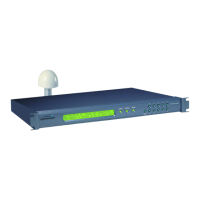APPENDIX C
• The unit responds with OK CR/LF.
Example: $B1
The above example illustrates enabling the 50/60Hz measurement option.
If the option is turned ON (enabled) and it isn’t available, the message “OPT?” will be sent.
1.5 ENTER 50/60Hz OFFSET DATA
This command allows the user to enter a starting point for the time error calculation.
• The user inputs $D (HEX 24, HEX 44) followed by one digit (sign), decimal point, followed
by four digits. The sign digit’s definition is 1 = + (plus) and 0 = - (minus).
• The unit responds OK CR/LF.
Example: $D 02.3406
The above example illustrates entering a time error offset of -2.0346 seconds.
Note: The time error offset can only be entered if the 50/60Hz measurement option is OFF.
If a time offset is entered while the 50/60Hz option is enabled, the message OPT ON will be
sent, and the time offset data is ignored.
The offset is stored in battery backed RAM, so it will be retained if the unit is turned OFF and
then back ON again.
1.6 REQUEST 50/60Hz MEASUREMENT DATA
This command allows the user to obtain the 50/60Hz measurement data.
• The user enters $A (HEX 24, HEX 41).
• The unit responds with XX.XXXX, space, Hz (representing frequency measurement), space,
±X.XXX, space, SEC (representing accumulated time error), space, XXX.X space, DEG
(representing phase angle measurement), space +X.XXXX, space, OFFSET (representing
time offset), CR/LF.
Example: 60.1324Hz + 1.357SEC 180.2DEG + 1.206 OFFSET CR/LF
The above response states that the frequency measurement is 60.1324Hz, and the accumulated
time error is +1.206 seconds.
C-26 ET6xxx ExacTime GPS TC & FG (Rev C) Symmetricom Inc

